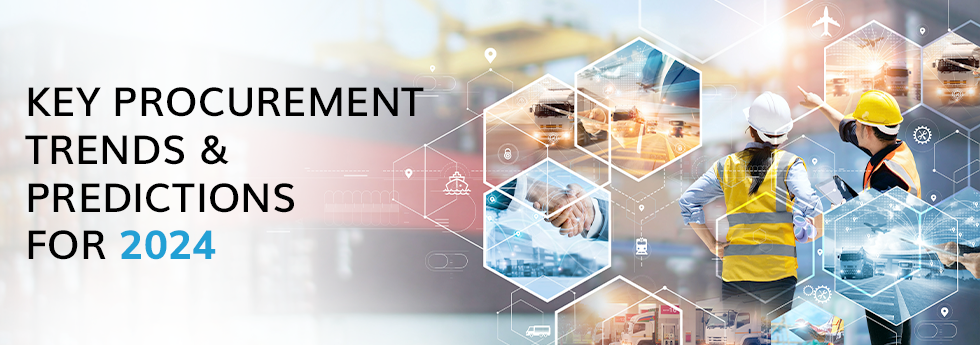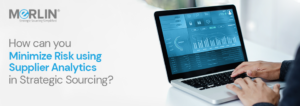Table of Contents
ToggleIntroduction
As uncertainty becomes the norm in today’s market, escalating geopolitical tensions, economic stagnation, and data security threats are placing considerable strain on the supply chain. These challenges are further compounded by the increasing reliance on advanced technology and evolving customer preferences, heightening the urgency for adaptability and innovation across the industry.
Regardless of the readiness, the procurement landscape is in the midst of a remarkable evolution, driven by digitization, technological advancements, and a growing focus on sustainability. This isn’t just about minor adjustments—it’s a sweeping transformation of business practices. As we move towards a future heavily influenced by automation and machine learning, the importance of staying ahead of the curve, while simultaneously prioritizing relevance and transparency, has never been more evident.
As per reports, The global procurement software market which was valued at USD 7158.52 million in 2022 is predicted to reach USD 14977.19 million by 2030. It is expected that the market could even exceed the predictions with a greater need to manage supply chain risks, optimization of cash flow, and ensure sustainable value.
So, what’s next? What procurement trends will shape global businesses in 2024 and beyond?
According to experts, the Future trends in Procurement are expected to be influenced by the growth in complexity and risks. Here are our predictions for the top procurement trends for 2024:
1. Developing Resilient Supply Chains
Procurement teams are aiming at a robust and efficient supply chain to navigate uncertainties and disruptions from the market. It also allows organizations to respond quickly to customer demands, and competitive pressures. The strategies that a resilient supply chain should follow are:
- Creating an end-to-end visible approach to supply chain helps identify any potential disruptions early on and mitigate their impact.
- Diversification of supply chains by collaborating with local suppliers, developing new delivery strategies, and sourcing from multiple vendors.
- Implementing duplicate systems, contingency plans, and alternate sourcing approaches to mitigate the effects of disruptions.
- Minimizing dependency on high-risk areas or offshore alternatives for purchasing supplies.
- Focusing on supplier relationship management strategies.
- Integrating sustainability into the procurement process and develop guidelines to outline specific requirements.
- Keeping a transparent reporting method, by regular communication and disclosure mechanisms.
2. Advanced analytics
Businesses have used spreadsheets to track essential supply chain management data for many years. While spreadsheets remain a useful tool for basic procurement tasks and simple data analysis, its limitations in handling large volumes of data, facilitating real-time collaboration, supporting advanced analytics, integrating with other systems, ensuring compliance and security, and scaling to meet growing business needs make it insufficient for modern procurement businesses.
Advanced analytics offers procurement professionals the ability to make data-driven decisions by comprehensively analyzing supply chains, identifying strengths, weaknesses, bottlenecks, and stress areas that significantly impact businesses. According to key findings from Gartner insights, 70% of organizations will need to transition their focus from big data to small and wide data to effectively harness available data resources.
Thus, now it’s high time for enterprises who haven’t yet realised its benefit to act and prepare for the future when big data and sourcing analytics will dominate the digital world.
3. Block Chain
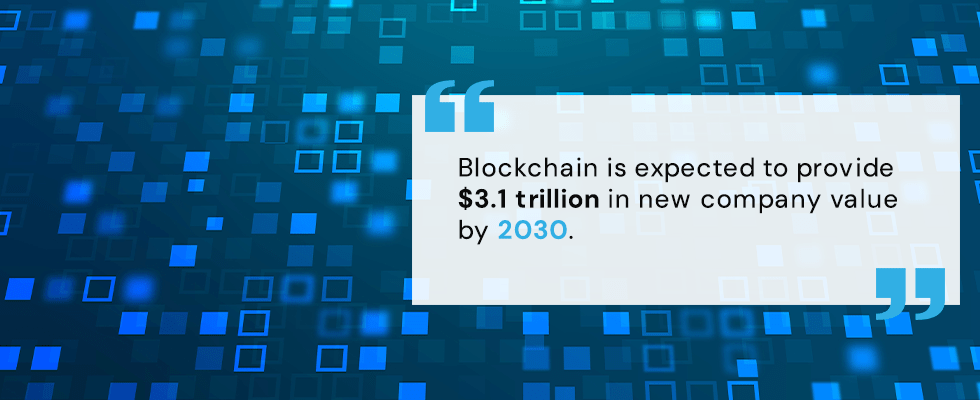
Blockchain also known as Distributed Ledger Technology (DLT) is a framework that stores transactional data in the form of blocks and shares it through a network connected through peer-to-peer nodes. For procurement, such systems promise to increase supply chain transparency and secure sensitive records, thereby minimizing interruptions and providing a definitive service to the customer.
Blockchain is expected to provide $3.1 trillion in new company value by 2030, according to Gartner, and businesses should start exploring it right away as it is definitely is going to be a major advancement for procurement in its way ahead.
4. Sustainability – The Greener Side
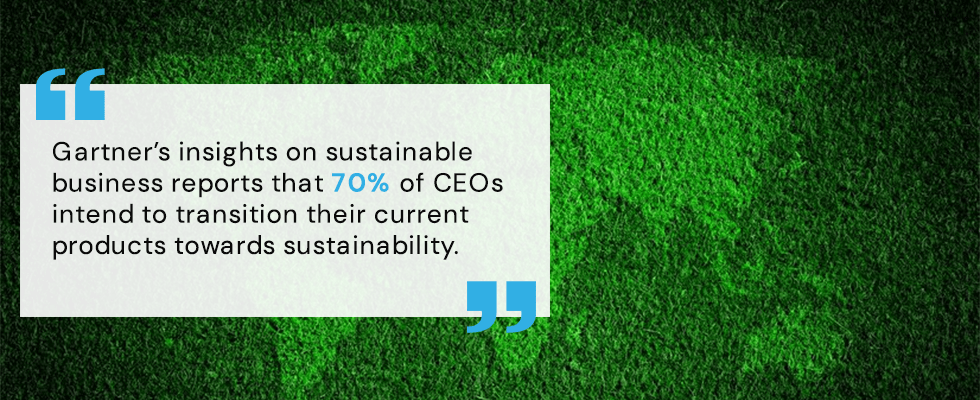
The global trend is shifting towards sustainability, demonstrated by the implementation of laws in numerous countries aimed at enforcing sustainable practices among organizations. Sustainability is playing a central role in shaping procurement trends by influencing supplier selection, supply chain transparency, risk management, circular economy practices, regulatory compliance, innovation, stakeholder expectations, and cost reduction efforts.
Gartner’s insights on sustainable business reports that 70% of CEOs intend to transition their current products towards sustainability, while 44% anticipate that climate change will pose challenges to the security of supply chain in the next decade. The article by Gartner also confirms that by 2027, a quarter of CIO’s remunerations will be linked to sustainable technology.
5. Cloud Solutions
Cloud technology, which is often a pay-as-you-go service, assists businesses in lowering expenses and scaling operations according to the organizations’ changing requirements. By making use of a variety of subscription-based models (Software as a service (SaaS), Platform as a service (PaaS), and Infrastructure as a Service (IaaS)), organizations can enhance business operations and gain several benefits such as:
- Best-fit solutions for the users
- Real-time data sharing
- Achieve cost savings by paying for only required features
- No custom coding is required
- Flexibility to work
6. Procurement as a Service
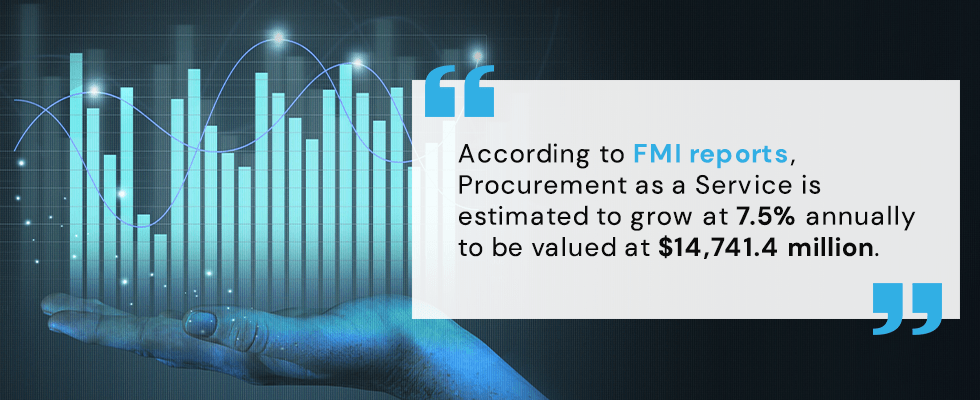
Procurement as a Service enables businesses to outsource their functions, anything from a menial job to a complex function. Leveraging the PaaS teams’ experience can help procurement teams make informed decisions and optimize their sourcing processes. Procurement as a Service offers a strategic approach to procurement management, enabling organizations to optimize their procurement processes in terms of costs, risks, and business value. According to FMI reports, Procurement as a Service is estimated to grow at 7.5% annually to be valued at $ 14,741.4 million.
7. Artificial Intelligence (AI)
Key insights from McKinsey confirms that the Artificial Intelligence is shaping the landscape of all industries alike. AI software promises to automate and expedite tedious processes while also providing insights based on substantial and complicated data sets. In procurement, AI is mainly being deployed for various applications related to contract management, spend analytics, and supplier data management.
8. IoT (Internet of Things)
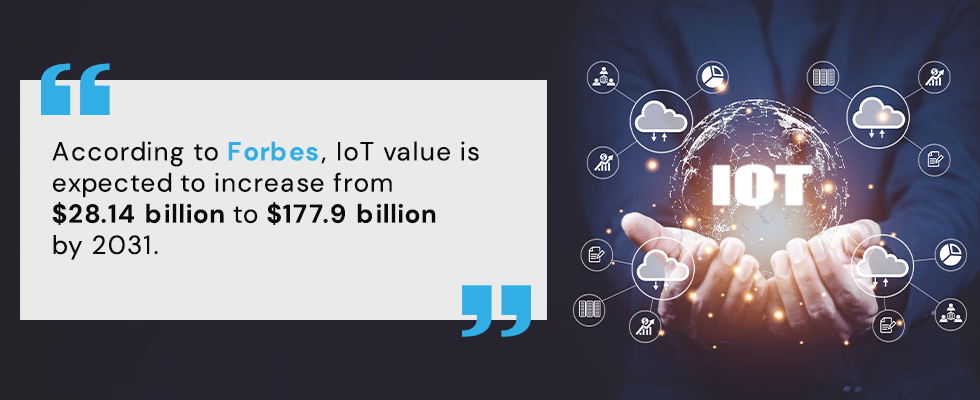
In the procurement domain, IoT serves as a game-changer by offering real-time tracking and monitoring capabilities for goods. By employing IoT technology, organizations can seamlessly monitor the condition and location of their products throughout the supply chain journey. By leveraging IoT data and analytics, organizations can accurately forecast demand, prevent excess stock accumulation, and avoid stockouts. With its ability to provide greater visibility and control over supply chain processes, IoT empowers organizations to make more informed decisions, optimize resource utilization, and mitigate risks effectively.
According to Forbes, IoT value is expected to increase from $28.14 billion to $177.9 billion by 2031. According to a recent Gartner survey, 47% of organisations plan to expand their investment in the Internet of Things (IoT).
9. Indirect Procurement – Facilitation Management
Following a more permanent move to remote working, indirect procurement will continue to develop enormously. Because a sizable number of the workforce is still committed to working from home, indirect procurement specialists will be tasked with facilitating this shift.
Gartner’s research shows that organizations focusing on human-centric workplaces are more likely to have high employee performance, retention rates, and lower employee fatigue levels compared to those with fewer human-centric attributes.
10. Data security and cybersecurity
As the world’s supply chains become largely digital, so does their vulnerability to cyberattacks. Supply chain partners may unintentionally expose one another and their clients to privacy violations, data thefts, and worse because of information exchange. Thus, procurement trends this year will urge businesses to invest in redundancies, firewalls, and advanced anti-hacking technologies in order to safeguard systems, networks, people and programmes as the trend in cybersecurity circles around AI, automation, and identity and access management.
11. Talent Management
With digital transformation increasingly standard in today’s procurement landscape, there’s a noticeable widening gap in talent availability. According to a survey by Gartner, merely 14% of procurement leaders feel assured that their current workforce is adequately equipped to meet demands. A staggering 68% identify technology and data skills as crucial requirements for their teams. Ideally, procurement leaders would benefit from a blend of traditional expertise and forward-thinking competencies. Achieving this involves a combination of strategic hiring practices and internal training initiatives designed to align with future requirements.
12. T-Shaped Procurement Team
The T-shaped procurement team reflects a progressive approach, wherein each member possesses specialized expertise in a particular domain while also maintaining a broad skill set across multiple disciplines. This unique structure facilitates effective collaboration among team members, allowing them to address specific challenges within their area of expertise while also contributing valuable insights from other fields.
The strategies that T shaped Procurement team can work on to maximise their efficiencies are:
- Engaging in cross training sessions to develop basic understanding of other specialisations.
- Implementing rotational assignments to foster deeper understanding of different aspects.
- Organising regular knowledge sharing sessions to ensure best practices and learnings are shared across.
- By collaborating with other departments to align strategies and objectives across the organization and leverage cross-functional expertise.
- Continuous learning enables team members to enhance their skills and stay updated on industry trends and best practices.
13. Inclusivity and Diversity
Inclusivity and diversity in procurement encompass a commitment to fostering an environment where individuals from all backgrounds, identities, and experiences are valued, respected, and empowered to contribute their unique perspectives and talents.
Government agencies and regulatory bodies are increasingly scrutinizing organizations’ diversity and inclusion efforts as part of their compliance monitoring and enforcement activities. Companies may be required to report on their diversity metrics, workforce demographics, and diversity initiatives to demonstrate compliance with legal requirements.
Conclusion – The Future Trends in Procurement
The procurement landscape in 2024 is undergoing a profound transformation, with sustainability and Artificial Intelligence (AI) emerging as the predominant driving forces. Organizations across industries are increasingly prioritizing sustainability, integrating eco-friendly practices and ethical sourcing into their procurement strategies. This shift reflects a growing recognition of the environmental and social impacts of supply chain operations, as well as the importance of meeting consumer expectations for sustainable products and practices.
The convergence of sustainability and AI in procurement represents a powerful synergy, as AI enables organizations to analyse vast amounts of data to identify sustainable sourcing opportunities, assess environmental impacts, and optimize resource allocation.
Also, according to Forbes: the top 5 factors for the companies to invest in emerging technologies over the next five years include, Generative AI, Sustainable Business, Data Analytics, Remote Work, Diversity and Inclusivity . Although predicting the future is a risky endeavour, but it’s better to be prepared rather than be taken off guard as the year 2024 progresses. So, start working on your procurement plans for the year by building a comprehensive digital roadmap to strengthen your procurement strategies!
In case you need any assistance in choosing your procurement solution, feel free to contact us. Leave a comment here if you think we missed out on any emerging trends in procurement! We’d love to hear your thoughts!
